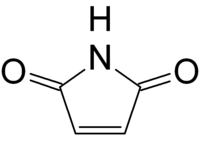- Maleimide
-
Maleimide  MaleimideOther names2,5-Pyrroledione
MaleimideOther names2,5-PyrroledioneIdentifiers CAS number 541-59-3 
PubChem 10935 ChemSpider 10471 
ChEBI CHEBI:16072 
ChEMBL CHEMBL387762 
Jmol-3D images Image 1 - C1=CC(=O)NC1=O
Properties Molecular formula C4H3NO2 Molar mass 97.07 g/mol Melting point 91-93 °C
Solubility in water organic solvents Hazards R-phrases R25 R34 R43 S-phrases S26 S36/37/39 S45  (verify) (what is:
(verify) (what is:  /
/ ?)
?)
Except where noted otherwise, data are given for materials in their standard state (at 25 °C, 100 kPa)Infobox references Maleimide is the chemical compound with the formula H2C2(CO)2NH (see diagram). This unsaturated imide is an important building block in organic synthesis. The name is a contraction of maleic acid and imide, the -C(O)NHC(O)- functional group. Maleimides also describes a class of derivatives of the parent maleimide where the NH group is replaced with alkyl or aryl groups such as a methyl or phenyl, respectively. The substituent can also be a polymer such as polyethylene glycol. Human hemoglobin chemically modified with maleimide-polyethylene glycol is a blood substitute called MP4.
Contents
Organic chemistry
Maleimide and its derivatives are prepared from maleic anhydride by treatment with amines followed by dehydration.[1] A special feature of the reactivity of maleimides is their susceptibility to additions across the double bond either by Michael additions or via Diels-Alder reactions. Bismaleimides are a class of compounds with two maleimide groups connected through a molecular unit and used as crosslinking reagents in polymer chemistry.
Natural Maleimides
Only a handful of natural maleimides - exemplified by the cytotoxic showdomycin from Streptomyces showdoensis.[2], and pencolide from Pe. multicolor[2] - have been reported. Farinomalein was first isolated in 2009 from the entomopathogenic fungus Isaria farinosa (Paecilomyces farinosus) - source H599 (Japan).[3]
Biotechnology applications
Maleimides linked to polyethylene glycol chains are often used as flexible linking molecules to attach proteins to surfaces. The double bond readily reacts with the thiol group found on cysteine to form a stable carbon-sulfur bond. Attaching the other end of the polyethylene chain to a bead or solid support allows for easy separation of protein from other molecules in solution, provided these molecules do not also possess thiol groups.
Technological applications
Mono- and bismaleimide-based polymers are used for high temperature applications up to 250°C.[4] Maleimides linked to rubber chains are often used as flexible linking molecules to reinforce the rubber (tire). The double bond readily reacts with all hydroxy, amine or thiol groups found on the matrix to form a stable carbon-sulfur, carbon-nitrogen or carbon-carbon bond.
See also
References
- ^ Cava, M. P.; Deana, A. A.; Muth, K.; Mitchell, M. J. (1973), "N-Phenylmaleimide", Org. Synth., http://www.orgsyn.org/orgsyn/orgsyn/prepContent.asp?prep=cv5p0944; Coll. Vol. 5: 944
- ^ a b J. H. Birkinshaw, M. G. Kalyanpur and C. E. Stickings. (1963). "Studies on the biochemistry of microorganisms. 113. Pencolide, a nitrogen-containing metabolite of Penicillium multicolor Grigorievna-Manilova and poradievova.". Biochem. J. 86: 237–243.
- ^ Sastia P. Putri, Hiroshi Kinoshita, Fumio Ihara, Yasuhiro Igarashi and Takuya Nihira. Farinomalein, a Maleimide-Bearing Compound from the Entomopathogenic Fungus Paecilomyces farinosus. J. Nat. Prod., 2009, 72 (8), pp 1544-1546 [DOI:10.1021/np9002806]
- ^ Lin, K.-F.; Lin, J.-S.; Cheng, C.-H. (1996). "High temperature resins based on allylamine/bismaleimides". Polymer 37 (21): 4729–4737. doi:10.1016/S0032-3861(96)00311-4.
External links
- The MP4 website, Molecule of the Month, December 2004
Categories:- Maleimides
Wikimedia Foundation. 2010.
